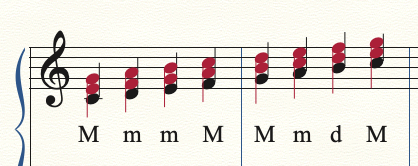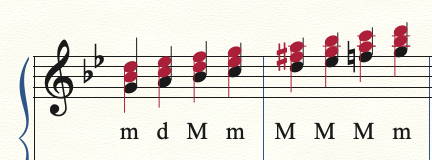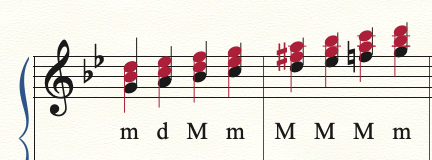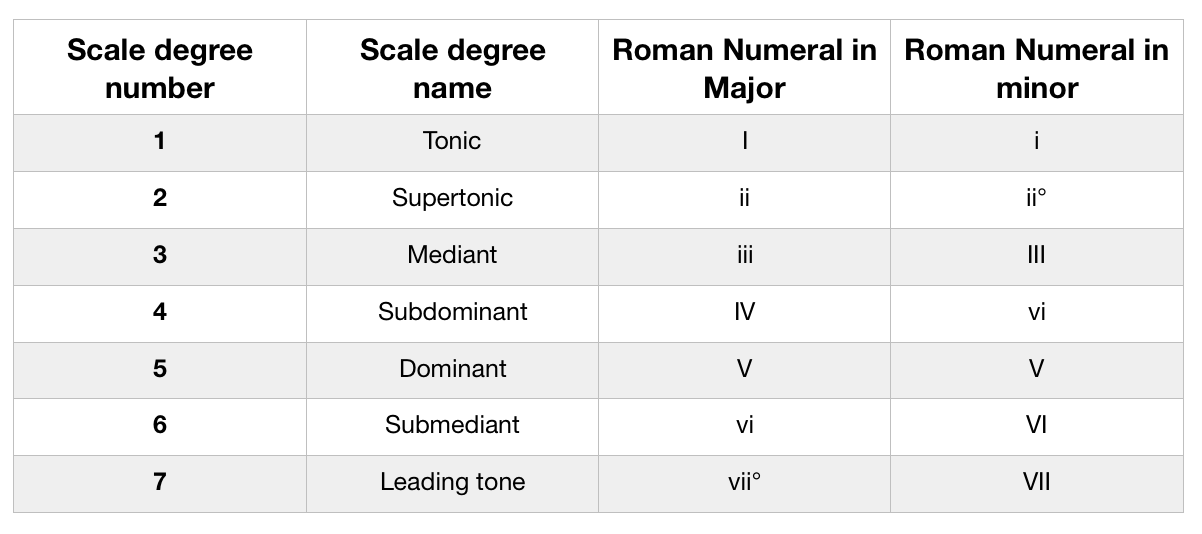3.2 Diatonic Chords and Roman Numerals
3 min read•january 13, 2023
AP Music Theory 🎶
72 resourcesSee Units
3.2: Diatonic Chords and Roman Numerals
There is, indeed, a rhyme and reason to all the various chords that are possible in all keys. Triads and seventh chords are built on the scale degrees of a given key. Diatonic means within the key, or from notes of the scale of the key.
Using the key of C Major, let's construct all the diatonic chords of C Major. First, we write the C Major scale:

Now, let's use the two lines or two spaces above each of the notes of the scale to construct the triad for each scale degree.

The next step is to discover the quality of each of these chords. Are they Major, minor, diminished, or augmented (M, m, d, A)? Remember, we look back to the quality of the triads within each triad to distinguish each type of chord.


The beauty of finding out the chord-quality patterns of one major scale, is that it applies to all major scales.

Minor scales take on a different pattern. Let's use the example of a G minor scale.

Now let's build the chords on top of each scale degree:

Note: For the V-chord, we actually make it into a major chord by altering the third of the chord. In a minor key, the V chord is naturally minor, but to keep it always as a major chord, we raise the third by a half-step. Look at the image below to see what that looks like.
And finally, let's discover what the quality of those chords are by identifying their triads.

Note that the second to last chord, the VII chord, is considered Major when built from the natural minor scale. When the scale is a harmonic minor or melodic minor scale, the F natural becomes an F# (hence, why the Dominant takes an F# in the triad). This will also makes the VII chord turn into a diminished chord. For this reason, the seventh chord in minor can be both Major or diminished, based on which type of minor the composer uses.
Chords of any key can also be identified using the scale degree names of each chord's respective root <hyperlink to unit 1.?>

*Take note, there are no naturally occurring augmented chords based on the diatonic scale. Augmented chords must be altered from a Major chord!
For example, we can refer to the "5" chord of any key as the dominant. If we have built a seventh chord on that 5-chord, we can refer to it as the "dominant seventh", which is a very common chord in music. This doesn't change whether it is in major or minor. The same is true with the "2" chord. We can refer to it as the "supertonic", which can infer a diminished chord if we are operating in a minor key.
Ingrain this information into your skull! You will need it for the rest of the material on the AP Music Theory test!

🦜 Polly wants a progress tracker: Can you spell all the diatonic triads in the key of B Major? How do you spell a dominant chord in the key of A Major?
Browse Study Guides By Unit
🎵Unit 1 – Music Fundamentals I (Pitch, Major Scales and Key Signatures, Rhythm, Meter, and Expressive Elements)
🎶Unit 2 – Music Fundamentals II (Minor Scales and Key Signatures, Melody, Timbre, and Texture)
🎻Unit 3 – Music Fundamentals III (Triads and Seventh Chords)
🎹Unit 4 – Harmony and Voice Leading I (Chord Function, Cadence, and Phrase)
🎸Unit 5: Harmony and Voice Leading II: Chord Progressions and Predominant Function
🎤Unit 7 – Harmony and Voice Leading IV (Secondary Function)
📝Exam Skills
📆Big Reviews: Finals & Exam Prep

Fiveable
Resources
© 2023 Fiveable Inc. All rights reserved.